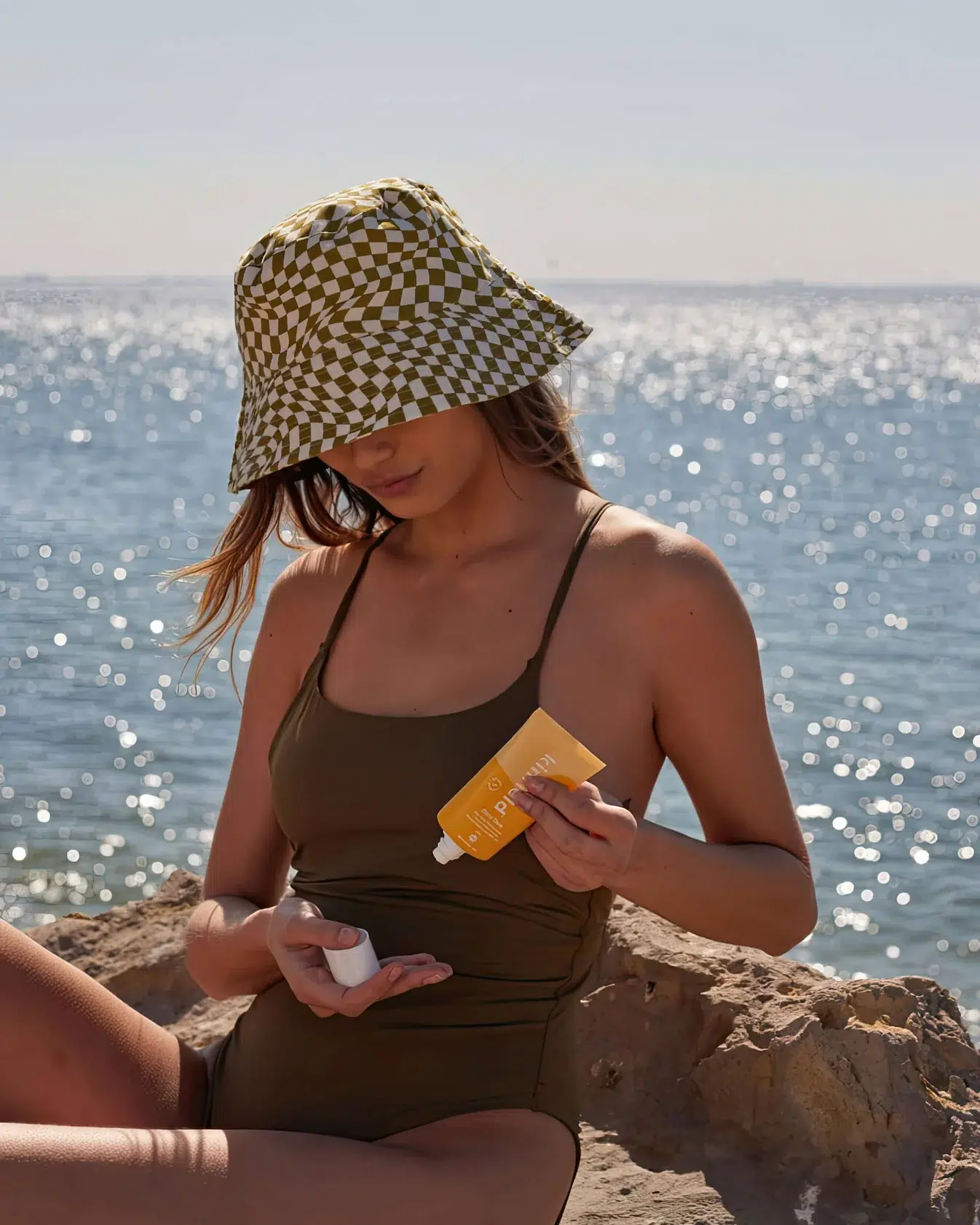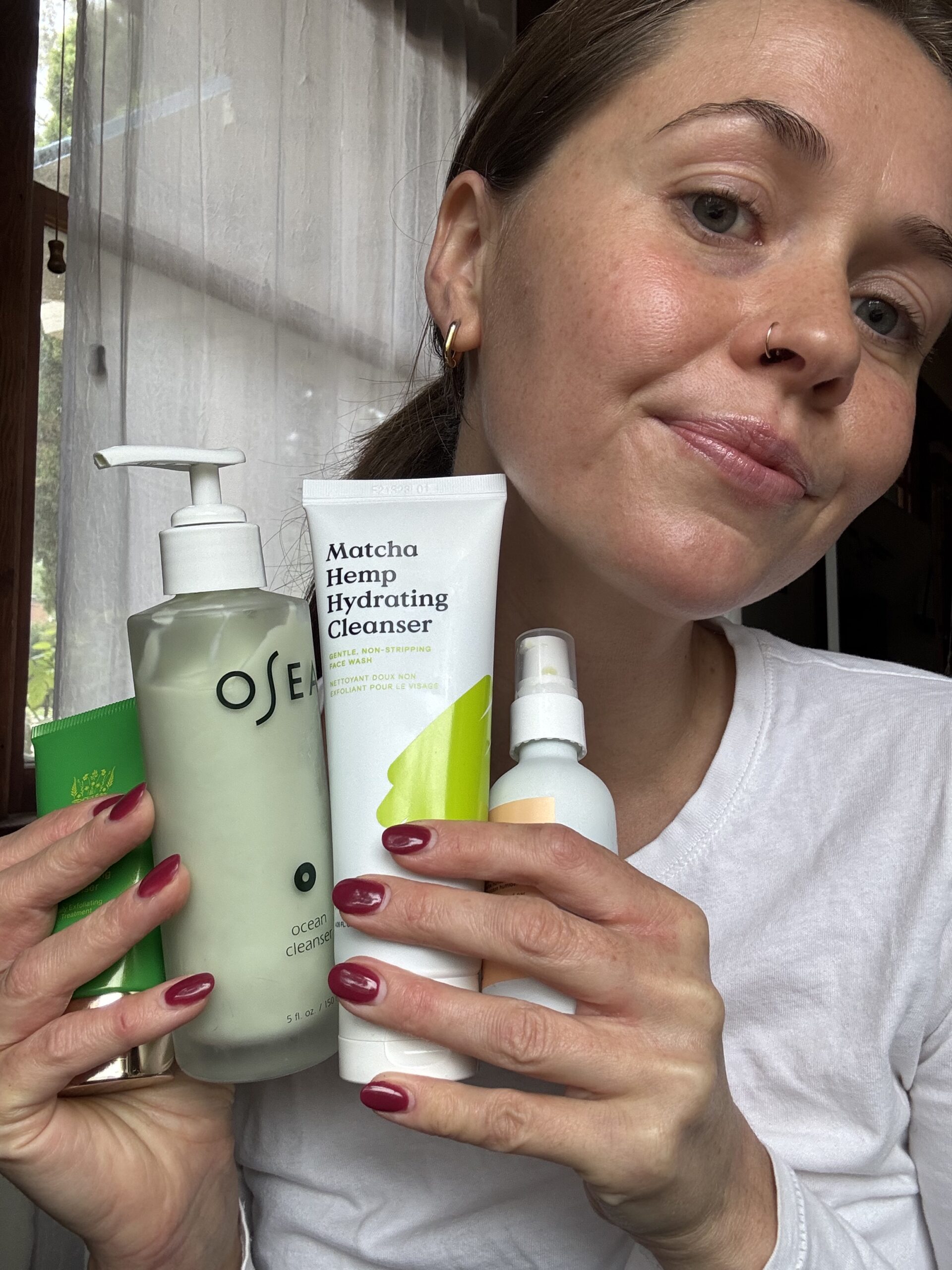
Interior Paint With No Offgassing, Is It Possible? (2025 ECOS Paint Review)
Summary: If you’re looking for a nontoxic, zero-VOC (and I mean truly zero-VOC) paint that doesn’t compromise on color or quality, I highly recommend ECOS Paints. I loved their ingredient transparency and the peace of mind knowing my bedroom is coated in gorgeous, safe color. While painting did take a bit more time — especially with bold colors needing primer and two coats — the beautiful, odorless finish made it all worthwhile. ECOS Paints is my top choice for anyone who wants a healthier, more sustainable option for their home.
Pros
- ECOS Paints’ line has zero VOCs (not just “low-VOC” like other brands) and is nontoxic and safe for sensitive individuals
- The brand offers Ingredient transparency and eco-certifications, in addition to being extremely high quality
- Not smelly — ECOS is virtually odorless — no need to vacate or air out for days
- The primer is tinted! It made me happy to be able to see a preview of what the final color might end up looking like
- ECOS offers a color match program, as well as offers over 1,300 colors (more than enough for me)
Cons
- For drastic color changes or old, textured walls, you’ll need a primer (but ECOS offers one that is designed to be optimal with their paints) and two coats of paint — worth the time in my opinion, but it’s not a quick process
- The tinted primer isn’t an exact match for the final coat — I suppose it’s both a pro and a con since you’ll know what spots need extra layers
- There’s a slightly higher price point than standard paints, but for as often as I paint my apartment, this cost is absolutely worth it
When I moved to my apartment nearly four years ago, I spent hours poring over color choices, taking inspiration from the bold colors of my favorite video game at the time — No Man’s Sky. I ended up selecting a sunset pink for my living room, cottagey yellow for my dining room, and (what I thought would be) a subtle, calming green for my bedroom.
I fell in love with each room instantly when they were finished, except the bedroom. What I thought would be a calm sage color ended up being a cool-toned, low-saturation, mashed-pea colored green. As the years went on, I referred to it as “vomit green.” The color itself wasn’t horrible, but for my space and the energy I was trying to welcome in? It just didn’t work.

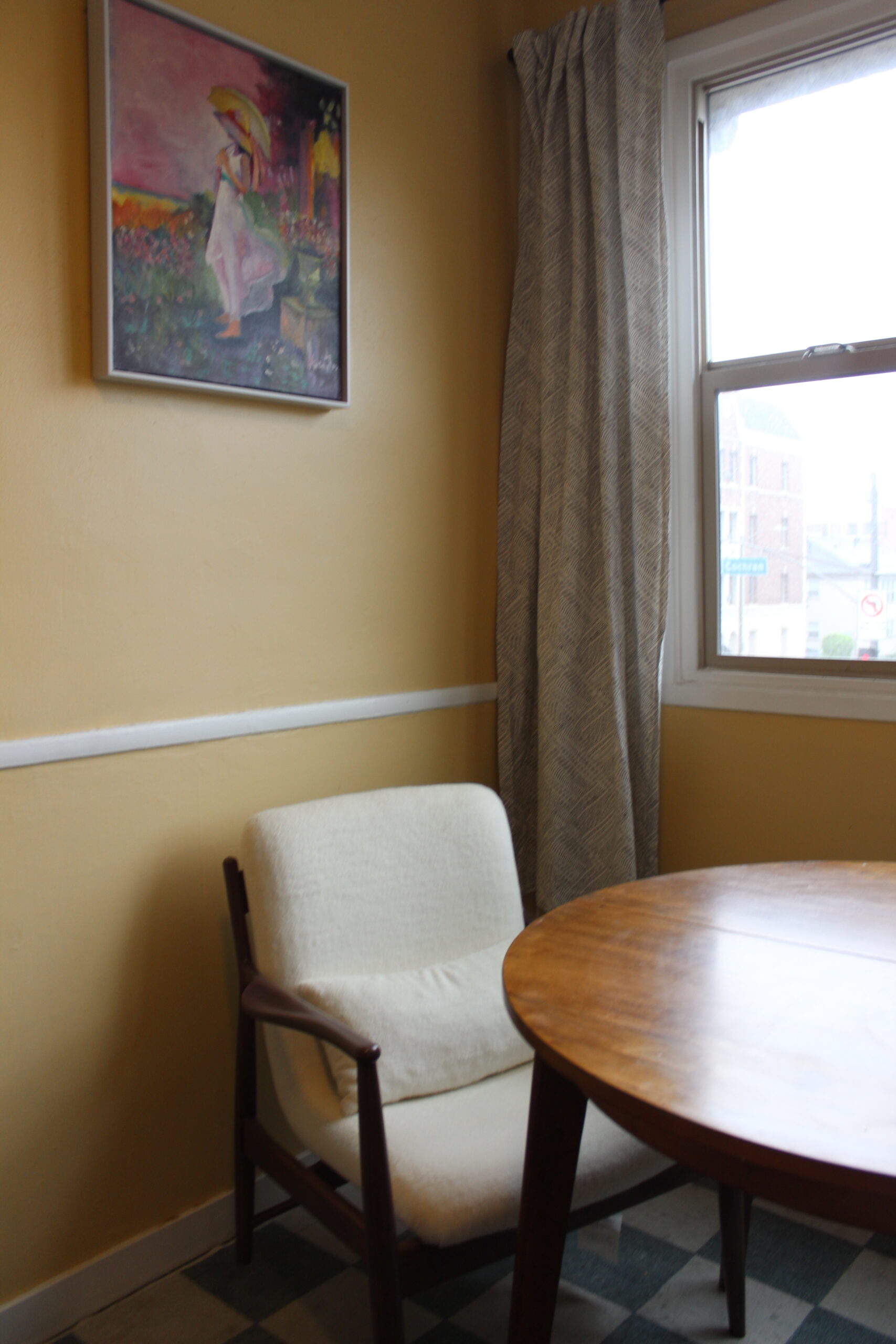

What’s more, my original paint job was half-hearted at best: We didn’t dust the walls first, slapped just one haphazard coat on, and then let the paint dry completely before pulling off the tape. There were giant missing sections of color, paint slopped on the ceiling and floor, and blotches where you could see the white paint still — I started and ended each day in a room that never felt like home.
“After he moved out, I knew I wanted to repaint as a symbolic gesture of new beginnings.”
But painting is hard work, and my former partner and I resigned ourselves to repaint “someday,” a day which never came. After he moved out, I knew I wanted to repaint as a symbolic gesture of new beginnings, but spent the next two years in overwhelm and upheaval as I navigated the new world I was entering into. But this year, it’s finally time.
So I swapped the signed divorce papers for paint swatches and began taking inspiration from wherever I could find it. I’ve long loved ECOS Paints since we first covered eco-friendly paint on The Good Trade in 2018, so this time around I decided to choose one of their colors instead of gathering swatches at Home Depot like some sort of paint-chip chipmunk.
Why did I choose ECOS?
ECOS Paints was founded in 1985 — 40 years ago! — by Ian West, with the original product being developed in the UK. ECOS products are now manufactured in Spartanburg, South Carolina where the brand’s headquarters lives as well. The brand’s mission has remained the same since its beginning: To develop clean, zero-VOC paint that consumers can feel good about using in their homes, where it could be well-loved for decades.
“The brand’s mission has remained the same since its beginning: To develop clean, zero-VOC paint consumers can feel good about using in their homes.”
One of the standout features of ECOS Paints — and why I felt compelled to try them — is their ingredient transparency. The brand lists all ingredients and published data sheets on its product pages, so you know exactly what’s in your paint. This level of disclosure is rare in the paint industry and immediately set ECOS apart for me. Plus, my favorite nontoxic furniture brand, Avocado, uses nontoxic ECOS stains on their handmade furniture pieces — and if it’s good enough for Avocado, it’s an absolute “yes” from me.


These water-based paints are truly zero-VOC, not just “low-VOC” like many competitors, which means there are no harmful solvents being released into your home during (and, less so, after) the painting process. The paint is also nontoxic, non-allergenic, and specifically formulated to be safe for those with asthma or chemical sensitivities. Safer for me and for my pets? Yes, please.
To top it off, ECOS cans are made from post-consumer recycled materials and are 100% recyclable, further reducing environmental impact.
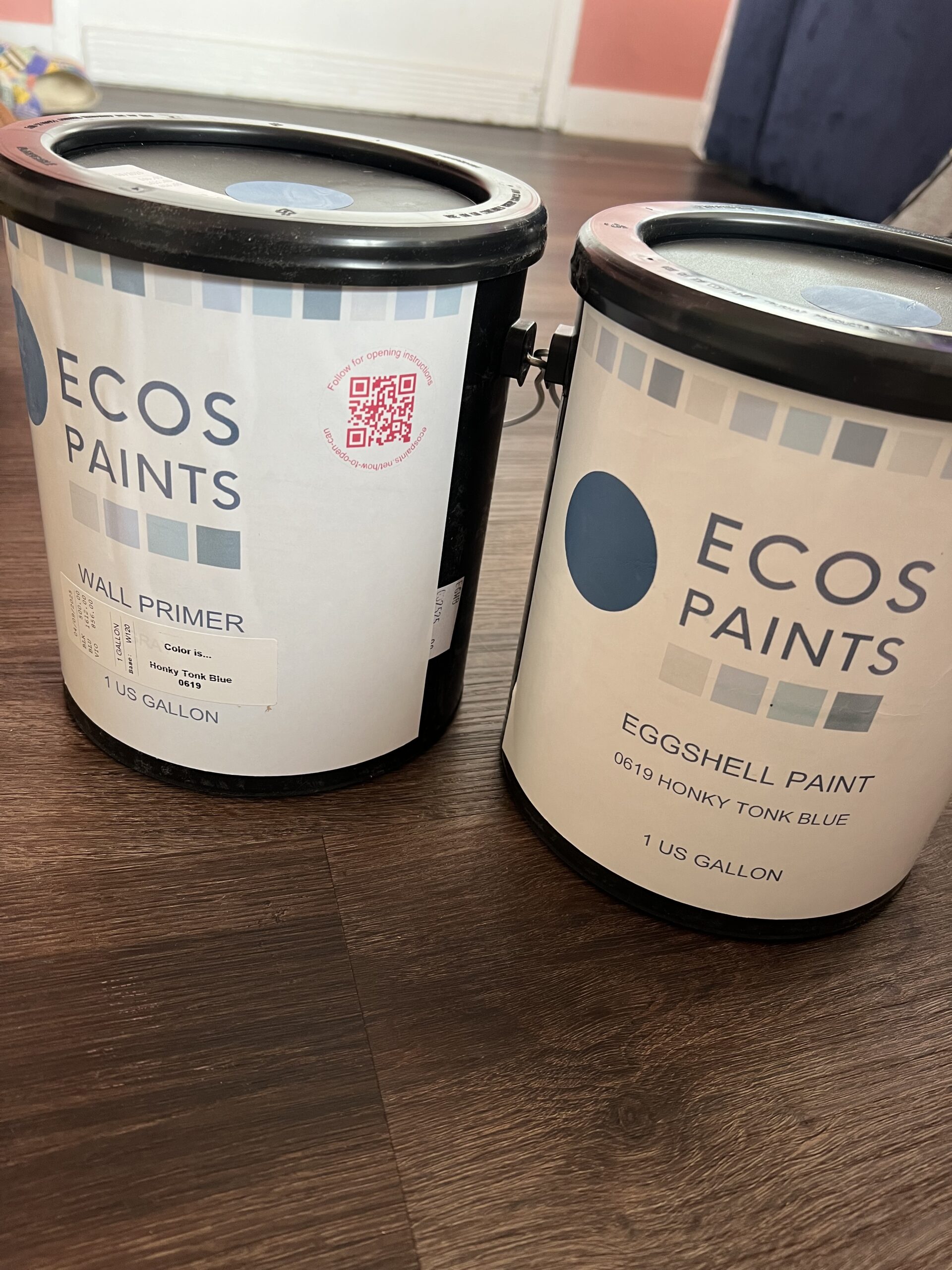
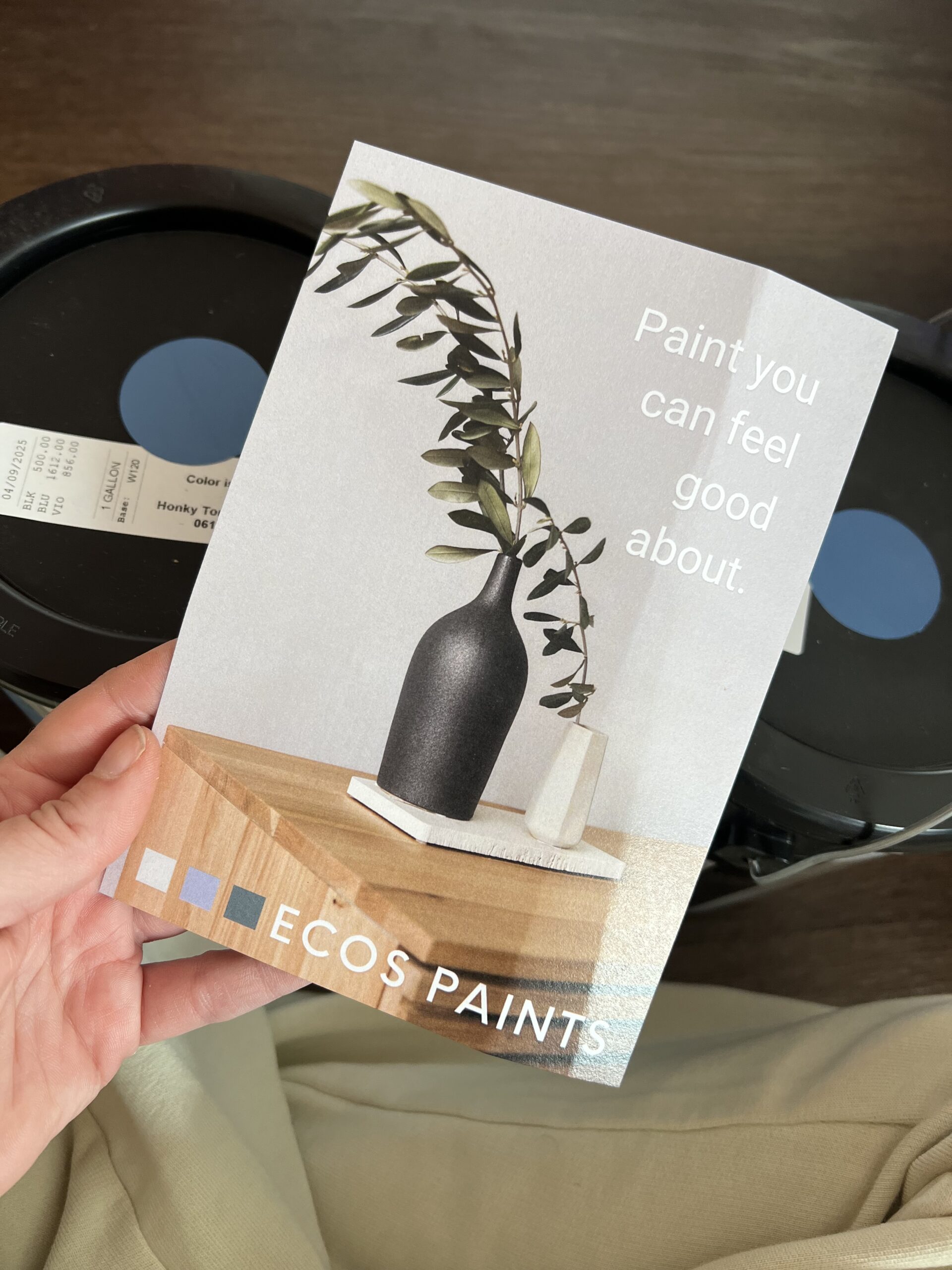
Most importantly, the brand has stunning color options. I love, love, love the amount of paint color options available — over 1,300. ECOS uses pure European pigments, resulting in a paint that’s richer and more vibrant, with a much higher solids content than typical paints and a broader coverage than average. You can really feel that when you’re reviewing the colors on the site and scrolling through reviews.
The paint color selection process
With over 1,300 options, I’ll admit that the selection process felt daunting. But ECOS has a solution for that, too! I ordered a full deck of color swatches and spent a couple of afternoons, mornings, and evenings reviewing how the colors might look in my space. At a cost of $22.95, it was a worthwhile starting point since I didn’t even know what color family I was going to select.


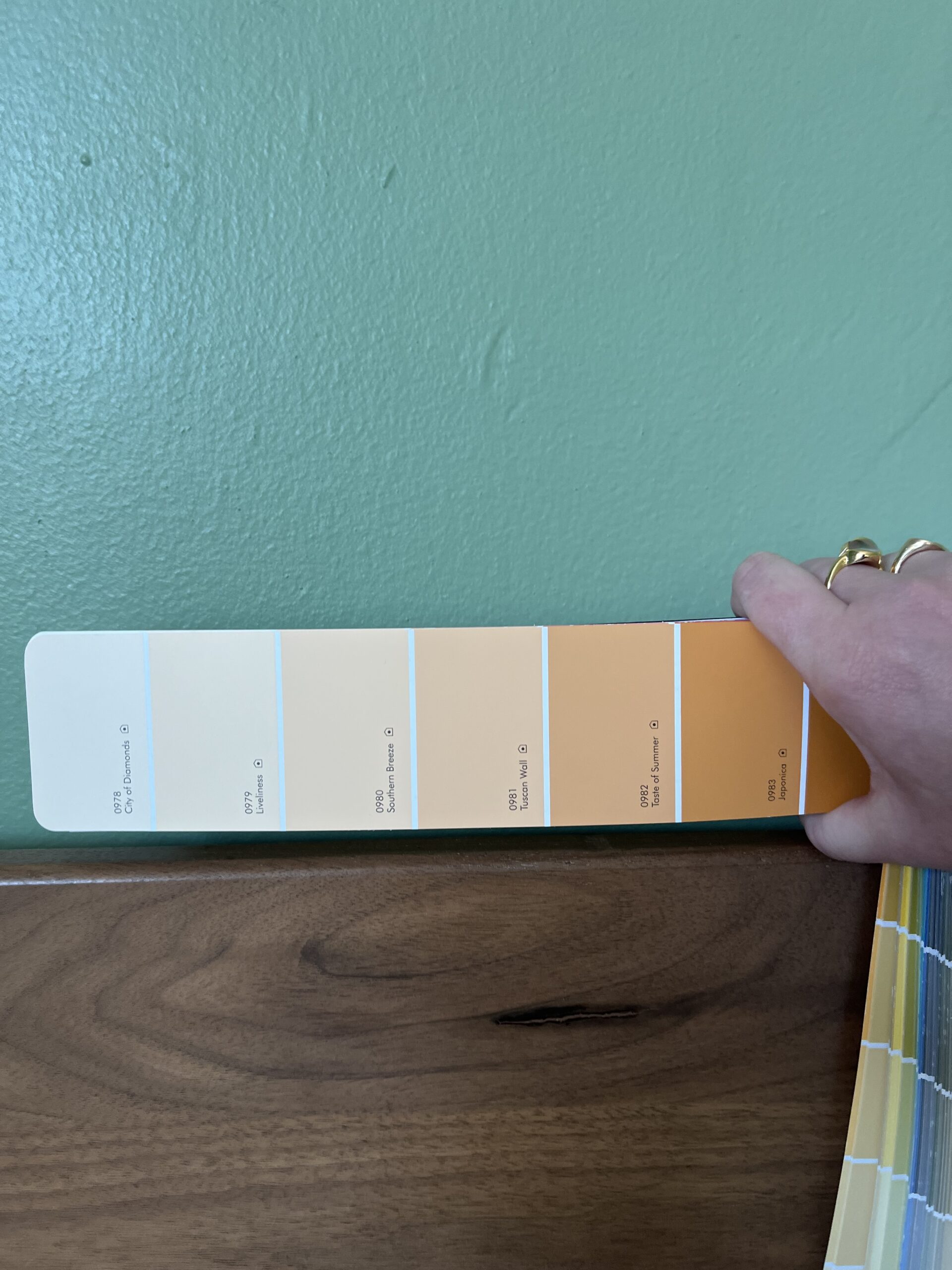
I’d suggest this approach to anyone who is torn between very different colors, and if you’re planning on painting more than one room now or in the future. (Or if you’re like me, you can always have a deck of inspiring colors on hand for new craft, home, or art projects).
Once I narrowed it down to 50 options (I know, it’s a lot), I added them all to a Google spreadsheet and worked my formula magic to see them all together on the screen. While a screen won’t ever show you the color in its realest form, I found this helpful to see what energies I was being drawn to and which ones stood out to me the most. I was able to narrow my selections to five — one yellow, two blues, and two pinks.


I then ordered two-ounce samples of each color to swatch on my wall IRL. They arrived quickly and were neatly stacked in a tube mailer, like the color swatch book had been. I swatched them on the wall that receives the most variations in daylight in a 24-hour span, and then sat with them for a few days on my wall as I determined which felt best.
While I was painting, I noticed that the yellow had a very low coverage rate over the green, so I also swatched the options on white notecards to get a clear idea of what the end product would look like after primer. The brand notes that this is one of the low-coverage colors, so if you’re painting over a darker color, you’ll definitely want a primer!


But I noticed almost immediately a sigh of relief move through my body when I painted the deeper of the two blues on my wall. Whenever I returned to my swatches, day or night, that blue called to me every time.
And so, Honky Tonk Blue it was.
Ordering was straightforward, shipping was fast, and soon enough, I had my paint and tinted primer (a recommendation for drastic color changes or older/textured walls). For my particular needs, I only needed one gallon of paint and one can of primer, which will do the job for most single rooms. Cue the painting montage!


The painting process with ECOS
As I embarked on this review, I knew one thing for certain: That I would paint my bedroom myself. No hiring a team, no help from friends, just me and a heart full of resolve as I build my home into a sacred space for myself.
(For someone who has also recently written about finding a balance when it comes to self-sufficiency, I am well aware of the irony.)
“I went all the way in with plastering, sanding, dusting, and washing my walls with a light detergent to ensure the dust didn’t cause any application issues.”
Because I wanted to do this right, I went all the way in with plastering, sanding, dusting, and washing my walls with a light detergent to ensure the dust didn’t cause any application issues. I’d been living with a large hole (and several small ones) in my drywall for years, thanks to some termite roommates 🐜, one of those “someday” fixes that never happened.
Admittedly, I got my drywall patch kit and painting supplies from Amazon — it got the job done, but I should have ordered the painting kit directly from ECOS or shopped at a local hardware store. The roller itself had extra fluff, and I found myself picking flakes of it off the wall as I progressed. I used to be just down the road from an Orchard Supply Hardware location, an old Southern California chain, but it’s many years gone and a Target took its place. (At least it’s not as bad as an occasional Spirit Halloween, but I digress.)


When it was time to paint, I started with ECOS’s tinted primer, which I discovered was a slightly lighter shade than the final Honky Tonk Blue. While the primer helped create a solid base, I did need two coats of the eggshell paint for full, even coverage-especially since the primer didn’t completely match the depth of the final color. You could even tell which wall I started on; it had a more amateur layer of initial coverage, but by the end of my project, I got much better.

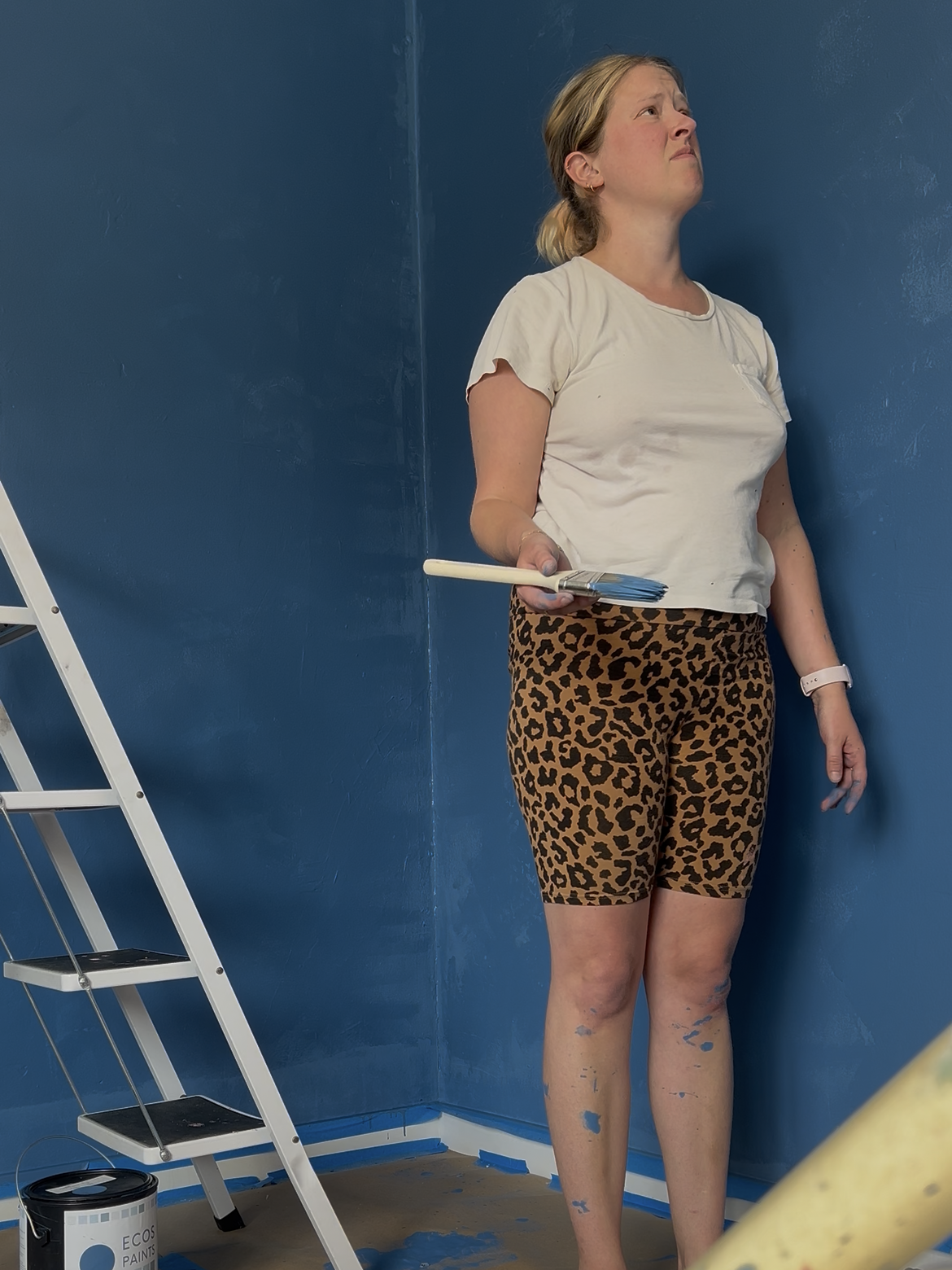

While the extra time wasn’t ideal for my arms and back, it ultimately led to a super-rich coverage that I’m obsessed with. This need for layering is consistent with ECOS’s own advice: for some bold or “poor hiding” colors, a tinted primer is recommended, but two coats may still be necessary for best results. The extra layer is time, I think, well spent.
“For some bold or ‘poor hiding’ colors, a tinted primer is recommended, but two coats may still be necessary for best results.”
There was minimal splatter, as long as I didn’t oversaturate the roller, and any drips were easy to wipe immediately. If anything sat for longer than ten minutes, though, I learned to let it sit without scrubbing until it was dry, then a magic eraser did the job of cleanup.
During the painting process, I was also paying close attention to my BlueAir 2-in-1 air filter and purifier, which contains a carbon and particle filter — another product I’m reviewing. The device shows the amount of pm2.5 particles in the air, and while paint VOCs are much smaller, the only time it warned me that my air quality was entering harmful territory was when I was sanding, letting the windows remain open too long, or moving dusty furniture and curtains. (I live on a busy street that sees *lots* of dust and sediment from the traffic, especially when my windows are open). I ultimately decided to mask up during the plastering, dusting, and sanding processes.

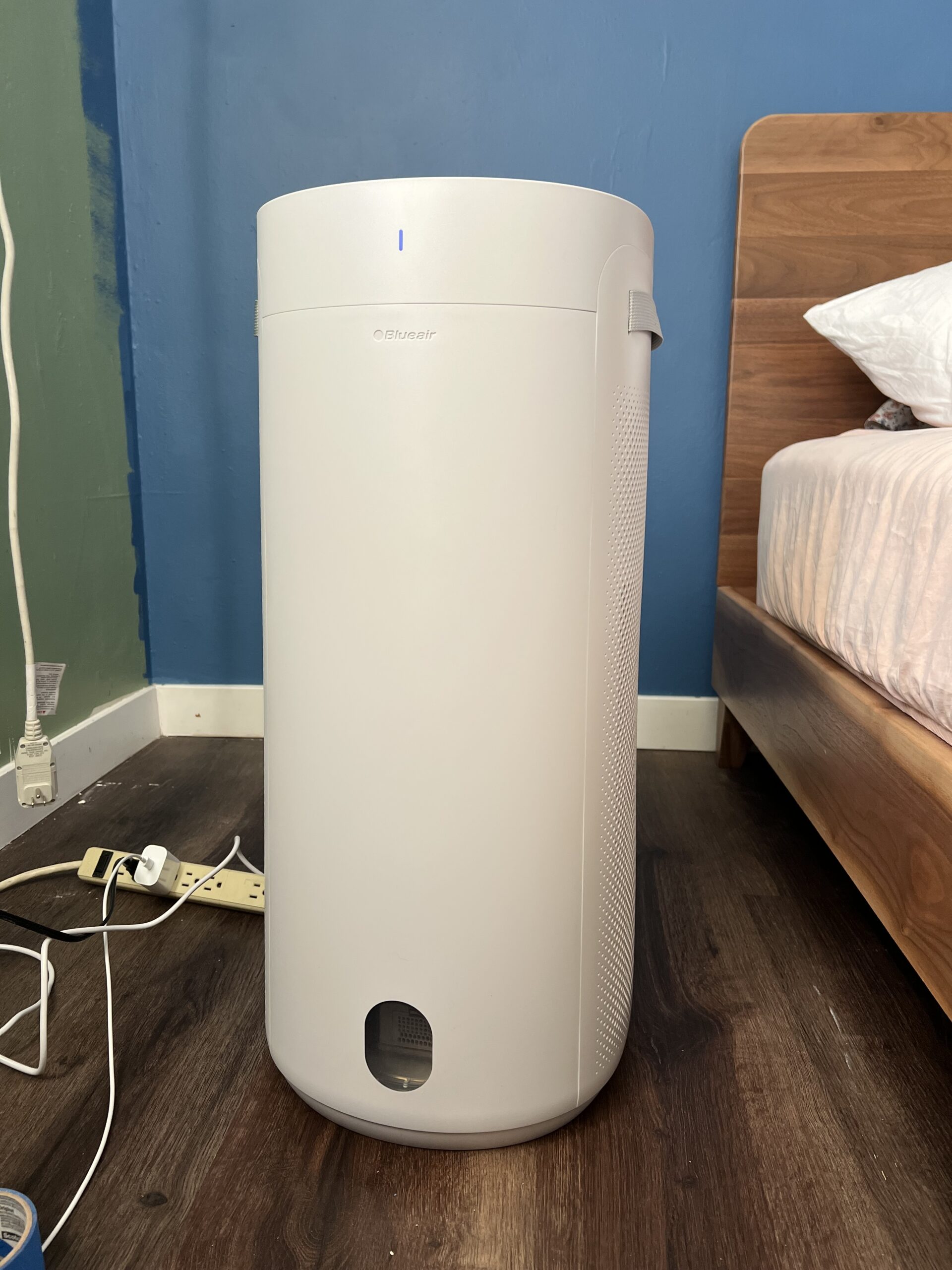

From my experience, though, I hardly smelled any of that new-paint smell, even when I smelled the paint directly in the can (probably not a great move, but hey! I want to review this stuff properly). My current partner, who is a little more sensitive to chemicals and odors, noted that there was a bit of a lingering smell but that it dissipated within a day with the windows open and air filter on.


How much time did it take?
ECOS paints dry quickly, and I was tempted to add more coats sooner than recommended, but I restrained myself. ECOS recommends waiting four hours between coats of both primer and paints for the boldest, strongest coverage. (Although the paint dries to the touch in as little as an hour!)
“ECOS recommends waiting four hours between coats of both primer and paints for the boldest, strongest coverage.”
The coats have been dry for about two weeks, and feel hard, durable, and — gasp! — my walls haven’t collected dust as they did previously. That could be the air filter’s doing; either way, I’m thrilled.
But it’s worth noting that doing this all myself has required a significant time investment. I promised myself I wouldn’t skimp on my attention to detail this time around, and I wanted to make sure I had the right color for my new chapter. Here’s a quick rundown:
- 5+ hours of perusing colors
- 5+ hours of swatching the paints in my room, watching how they behave in the light, and contrasting them with my existing furniture
- 10+ hours of sanding, washing, and taping my walls
- 10+ hours of moving furniture, removing and replacing shelves, and of course, cleanup after (see more about my spill disaster below)
- 20+ hours of painting over the span of two weeks (primer, then two layers of paint)
Overall, worth it — but if you can afford a pro to handle it, good for you. Otherwise, I recommend inviting friends for a painting party.
There was only one disaster when I moved my ladder and spilled the paint can; the lid wasn’t sealed all the way, and I lost a lot of good paint that day. 😞 I scooped up what I could then put paper towels over what had spilled on my vinyl flooring. Partially to hide it from myself while I had a good, exhausted cry, and partially to help with scrubbing it later. It added time to the process, but ultimately, I was able to clean it up without too much lingering residue.
Is ECOS Paints right for you?
If you’re looking for a paint that aligns with a sustainable, health-conscious lifestyle, ECOS delivers on all fronts. The peace of mind that comes from knowing your walls aren’t off-gassing harmful chemicals is invaluable, especially if you have children, pets, or sensitivities in your household.
“If you’re looking for a paint that aligns with a sustainable, health-conscious lifestyle, ECOS delivers on all fronts.”
The eggshell finish in Honky Tonk Blue brought a vibrant, even color to my space, and the application process was straightforward. While you may need two coats of paint for bold colors and the primer might not be a perfect match, the end result is worth it for the air quality and environmental benefits.
Would I use ECOS again? Absolutely. The combination of sustainability, nontoxicity, and real-world performance makes it a top contender for anyone serious about creating a healthy home. ECOS Paints comes in a huge range of vibrant colors, has nearly no offgassing smells, and dries with a beautiful, durable finish.
Next up — my kitchen? Drop your color recos in the comments below, I am ready for more big changes.




Emily McGowan is the Editorial Director at The Good Trade. She studied Creative Writing and Business at Indiana University, and has over ten years of experience as a writer and editor in sustainability and lifestyle spaces. Since 2017, she’s been discovering and reviewing the top sustainable home, fashion, beauty, and wellness products so readers can make their most informed decisions. Her editorial work has been recognized by major publications like The New York Times and BBC Worklife. You can usually find her in her colorful Los Angeles apartment journaling, caring for her rabbits and cat, or gaming. Say hi on Instagram!

